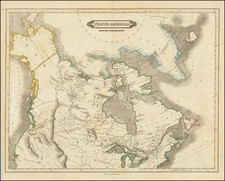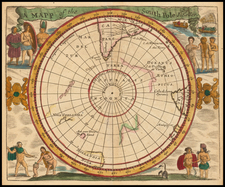Scarce map of the routes of the British explorers on the Coppermine expedition.
The map illustrates the daily movements of Sir John Franklin's watercourse beginning in September 1819 at York Factory, near Hudson Bay and concluding at Cumberland House, north of Lake Winnipeg, through Manitoba and Saskatchewan, prepared to accompany the first edition of Franklin's Narrative of his second expedition to the Arctic.
Coppermine Expedition
The Coppermine expedition of 1819–1822 was a British overland undertaking to survey and chart the area from Hudson Bay to the north coast of Canada, eastwards from the mouth of the Coppermine River. The expedition was organized by the Royal Navy as part of its attempt to discover and map the Northwest Passage. It was the first of three Arctic expeditions to be led by John Franklin and also included George Back and John Richardson, both of whom would become notable Arctic explorers in their own right.
The expected assistance from the local fur trading companies and native peoples was less forthcoming than expected. Poor supply lines, coupled with unusually harsh weather and the resulting absence of game, meant the explorers were frequently near starvation. Eventually, the Arctic coast was reached, but barely 500 miles had been explored before the exhaustion of the party's supplies and the onset of winter forced them to turn back.
What followed was a desperate retreat across uncharted territory in a state of starvation, with 11 of the party of 22 dying enroute amid accusations of murder and cannibalism. The survivors were rescued by members of the Yellowknives Nation, who had previously given them up for dead.
In the aftermath, Franklin was criticized by local fur traders for his haphazard planning and failure to adapt. Back in Britain he was received as a hero and fêted for the courage he had shown in extreme adversity. The expedition captured the public imagination, and in reference to a desperate measure he took while starving, he became known as "the man who ate his boots".










![(Czech Settlement in Manitoba) Mapa státu: Manitoba a kanádského Severozápadu s rozlíčnym železničním spojením a českymi a německymi osady | Manitobe Nove Cechy Hohenlohe-Langeburg [State Map: Manitoba and the Canadian Northwest with railway connections, including Czech and German settlements | Manitoba, New Cezchia]](https://storage.googleapis.com/raremaps/img/small/88274.jpg)
![Originalkarte zur Ubersicht des Standpunktes neuester Polarforschungen bis Ende September 1874. [with:] Provisiorische Skizze von Franz Joseph Land entdeckt von der 2. Oster.-ungar. Nordpolar-Expedition 1873 & 1874](https://storage.googleapis.com/raremaps/img/small/98481.jpg)
![[ California To Alaska -- Northwest Passage ] Quivirae Regnu cum alijs versus Borea](https://storage.googleapis.com/raremaps/img/small/60083.jpg)

